
Geospatial technologies have won big at this year’s iAwards, which recognise companies and individuals who have excelled in their field of ICT and are deserving of recognition at a national level.
Both the creators of Google Maps and Esri Australia received recognition at this year’s ceremony, for their respective contribution to Australian ICT and the community.
In the biggest field of the program’s 17 year history, winners were announced in four individual categories, 16 company categories and two distinguished achievement awards: the Tony Benson Entrepreneur Award and the Pearcey Medal for lifetime achievement in ICT.
The 2011 Benson Entrepreneur Award was presented to Lars and Jens Rasmussen, founders of Google Maps and Google Wave by Dr Ian Oppermann, Director of the ICT centre, CSIRO, which has been a major supporter of the Pearcey and the Benson Entrepreneurial Awards for many years.
Dr Oppermann commented: “Lars and Jens's development of Google Maps has positioned Australia as a global leader in online services. It resulted in Google establishing a significant research and development team in Sydney and the creation of many high tech jobs. Google Maps is now used by around 1/3 of all Google visitors and represents over 3% of all total global Google traffic. Clearly this is a fine example of Australian ingenuity making an outstanding global impact and literally put Australia ‘on the map’.”
Esri Australia won a Merit for the Brisbane City Council (BCC) Flood Map website, which was developed using GIS technology. Esri Australia has now been invited to take their innovation to Thailand, to compete in the Asia Pacific ICT Alliance Awards later this year.
The flood map website compiled flood data from across disaster-struck Brisbane – such as flood peaks, road closures and evacuation centres – onto a map to provide a comprehensive, real-time picture of the flood.
It was a key information source for emergency response teams and the Brisbane City Council, guiding recovery operations and supporting critical decisions; and received more than three million hits from members of the public who accessed the map at the height of the crisis.
The ongoing development of the solution during Queensland’s Tropical Cyclone Yasi saw the integration of social media updates – the technology crowd sourced tweets, Flickr photos and YouTube videos and linked them to their relevant location on the map.







